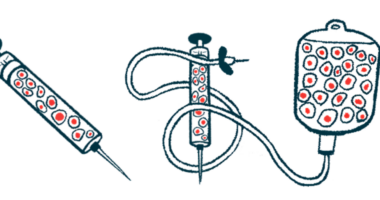NfL blood levels may help predict long-term progression of MS: Study
Elevated nerve damage markers found even with no acute relapses

Elevated blood levels of neurofilament light chain (NfL), a marker of nerve damage, are associated with long-term disability progression in people with multiple sclerosis (MS) — even among those without acute relapses or MRI disease activity — a study revealed.
The results demonstrate the potential utility of NfL blood tests as a predictive biomarker of increased risk for clinical progression.
“Our findings reveal that, beyond the recognised association with acute relapsing MS biology, elevated NfL levels in the absence (or during effective suppression) of acute MS disease activity can reflect injury due to non-relapsing progressive biology,” the researchers wrote.
“We provide evidence to support NfL as a potentially clinically actionable biomarker,” they added.
The study, “Blood neurofilament light levels predict non-relapsing progression following anti-CD20 therapy in relapsing and primary progressive multiple sclerosis: findings from the ocrelizumab randomised, double-blind phase 3 clinical trials,” was published in the journal eBioMedicine.
Evaluating patients from pivotal Ocrevus study
In MS, the immune system wrongly damages the myelin sheath, the fatty insulating layer that covers nerve fibers in the brain and spinal cord. This disrupts the body’s ability to transmit electrical signals, resulting in a range of symptoms.
Most commonly, people with the autoimmune disorder have a form of the disease called relapsing-remitting MS (RRMS), in which they experience new symptoms as isolated relapses. After a relapse, symptoms may ease or disappear entirely in some patients, but others may have permanent problems and nerve damage. Such symptoms are referred to as relapse-related progression.
After many years in most patients, RRMS can transition to secondary progressive MS, in which individuals experience continuous worsening of symptoms even in the absence of relapse activity.
For about 15% of patients, MS is marked by the continuous progression of disability from symptom onset — a form of the disease called primary progressive MS (PPMS).
Neurofilament light chain, known as NfL for short, is a structural protein that’s released upon nerve damage. High levels of this protein in circulation have been linked with MS relapse activity — and have been shown to predict future relapse-related disease progression. However, the ability of NfL to capture non-relapsing disease progression remains unclear.
Now, researchers based at the University of Pennsylvania postulated that suppressing relapses and MRI activity with targeted therapies may reveal a relationship between NfL and non-relapsing progressive disease.
To find out, the team analyzed blood samples collected from participants in the pivotal clinical trials that supported the regulatory approvals of Ocrevus (ocrelizumab).
That therapy has been shown to significantly reduce disease activity and limit disability progression. This study was funded by Roche, whose subsidiary Genentech, developed Ocrevus.
In all, researchers used data from 1,421 people with relapsing MS and 596 with PPMS involved in the trials.
The relapsing MS patients who had participated in the OPERA I (NCT01247324) and OPERA II (NCT01412333) Phase 3 clinical trials had been randomly assigned to either Ocrevus or Rebif (interferon beta-1a), another medication. Meanwhile, PPMS patients in the Phase 3 study called ORATORIO (NCT01194570) were randomly selected to receive Ocrevus or a placebo.
Before treatment (baseline), NfL levels were significantly elevated in both relapsing MS and PPMS patients compared with levels found in a group of 118 healthy people, who served as controls. While individuals with acute disease activity showed the highest NfL levels, those amounts also remained elevated in those without disease activity.
In relapsing MS patients without disease activity who received Rebif, and in PPMS patients receiving a placebo, higher baseline NfL levels predicted MS progression and worse MRI activity during the study. In contratst, among those receiving Ocrevus, baseline NfL was not associated with future disability progression, new lesions, or greater brain volume loss.
Study: NfL blood levels may be better marker than MRI
After three months of Ocrevus, NfL levels significantly dropped in both relapsing and primary progressive MS patients. These reductions were even more pronounced by the end of the initial treatment period, which was 96 weeks or nearly two years in relapsing MS, and 120 weeks, or a little longer than two years, in PPMS.
By week 96, age-adjusted NfL levels in relapsing MS participants receiving Ocrevus were reduced to the levels observed in healthy controls. In PPMS patients, NfL also was significantly reduced but the effect was less pronounced.
In Ocrevus-treated patients, researchers discovered a significant association between high NfL at week 24 and week 48 and a long-term risk of disability progression. For people with high levels at those six-month and nearly one-year time points, the risk of progression was elevated at end of the initial treatment period and remained so after almost nine years of follow-up in open-label extension studies.
In total, 18.9% of relapsing MS and 67.3% of PPMS patients receiving Ocrevus had high NfL levels at week 48, which reflected a “risk for future non-relapsing progression,” the team wrote.
Elevated NfL levels in the absence, or effective suppression, of acute disease activity reflect increased risk for non-relapsing disability progression.
Factors potentially driving elevated on-treatment NfL levels in both groups included a greater total loss of brain volume and higher volumes of slowly expanding lesions (SELs), which are MRI markers of chronic active lesions. Other influencing factors included lower body weight, male sex, and living in the U.S.
Finally, NfL blood levels at 48 weeks, instead of MRI measures, accounted for the greatest reduction in clinical progression with Ocrevus treatment in relapsing MS, “suggesting that NfL may be a better proxy for treatment effect than MRI measures in shorter clinical studies,” the researchers wrote.
“Elevated NfL levels in the absence, or effective suppression, of acute disease activity reflect increased risk for non-relapsing disability progression,” the team concluded.
“On-treatment NfL levels show potential utility for risk stratification and exhibit elements of a surrogate biomarker endpoint that, if validated, may help accelerate development of novel treatments that more effectively impact non-relapsing progressive MS,” they added.







